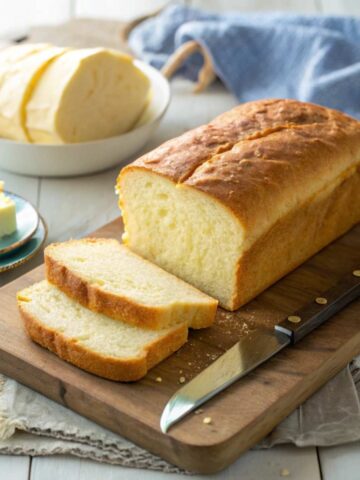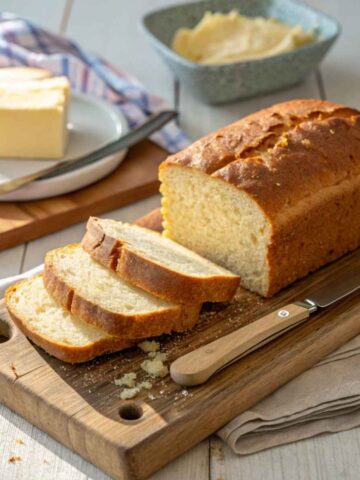Cornbread has a long history as a Southern staple, beloved for its simple ingredients and versatility. Whether it’s served as a side dish to chili or enjoyed with butter and honey, cornbread has a warm place in many kitchens. But if you’re on a gluten-free diet, making cornbread that’s just as fluffy and delicious as the original can be a challenge. Luckily, with a few tweaks, you can easily create a gluten-free cornbread that satisfies your cravings without compromising flavor or texture.

This guide explores how to make the perfect gluten-free cornbread, what ingredients to use, and some creative twists to spice up this classic dish.
Jump to:
- What is Gluten?
- Is Cornmeal Gluten-Free?
- Key Ingredients for Gluten-Free Cornbread
- Tips for Making Fluffy Gluten-Free Cornbread
- Sweet or Savory: Which Cornbread Do You Prefer?
- Creative Variations of Gluten-Free Cornbread
- Gluten-free cornbread Muffins
- How to Make Gluten-Free Cornbread Moist
- Gluten-Free Cornbread in Cast Iron vs. Baking Dish
- Gluten-Free Cornbread Stuffing for the Holidays
- The Nutritional Benefits of Gluten-Free Cornbread
- Storing and Freezing Gluten-Free Cornbread
- Serving Suggestions for Gluten-Free Cornbread
- Conclusion
- FAQs
What is Gluten?
Understanding Gluten and Its Role in Baking
Gluten is a protein found in wheat, barley, and rye that gives baked goods their structure and elasticity. In traditional baking, gluten helps trap air bubbles, offering breads and cakes a chewy and airy texture.
Why Gluten-Free Diets are Essential for Some People
Consuming gluten can lead to serious health issues for people with celiac disease, non-celiac gluten sensitivity, or a wheat allergy. A gluten-free diet is essential for managing symptoms and maintaining good health. However, removing gluten from baking can sometimes result in dry or crumbly textures. Hence, we must adjust ingredients and techniques to make gluten-free cornbread.
Is Cornmeal Gluten-Free?
Different Types of Cornmeal: Fine, Medium, and Coarse
Cornmeal is made from dried corn and is naturally gluten-free, but not all cornmeal is processed in gluten-free environments. Certified gluten-free cornmeal ensures there’s no cross-contamination during processing.
Cornmeal comes in different textures:
- Fine cornmeal creates a smoother, more cake-like cornbread.
- Medium cornmeal adds a bit of texture without being too gritty.
- Coarse cornmeal provides a more rustic, crumbly texture, which some people prefer for traditional Southern-style cornbread.
The Importance of Choosing Certified Gluten-Free Cornmeal
Even though corn is naturally gluten-free, choosing certified gluten-free cornmeal to contaminate gluten during processing is essential. Look for labels that specifically state the product is gluten-free.
Key Ingredients for Gluten-Free Cornbread
Cornmeal is the Star Ingredient
Cornmeal is the base of any cornbread, giving it its signature flavor. To make gluten-free cornbread, you’ll want to mix cornmeal and gluten-free flour to get the right texture and structure.
Substituting Gluten-Free Flour for Wheat Flour
To replace wheat flour, choose a high-quality gluten-free blend containing xanthan gum or guar gum to help bind the ingredients together. You can also experiment with different gluten-free flours, like almond or coconut flour, to add extra flavor and texture.
The Role of Eggs, Milk, and Fat
Eggs help with the binding process and give the cornbread a fluffy texture, while milk (dairy-free milk) adds moisture. Fat, such as butter or oil, adds richness and helps keep the cornbread tender.
Tips for Making Fluffy Gluten-Free Cornbread
How to Keep Cornbread Light and Moist Without Gluten
The key to making gluten-free cornbread fluffy is to use suitable leavening agents. Baking powder and baking soda help the batter rise, while eggs provide structure. Don’t overmix the batter—this can cause the cornbread to become dense.
Choosing the Right Leavening Agents
Always use fresh baking powder and baking soda to ensure your cornbread rises appropriately. If you want extra lift, you can separate the egg whites, whip them into stiff peaks, and gently fold them into the batter before baking.
Sweet or Savory: Which Cornbread Do You Prefer?
Cornbread can be sweet or savory, depending on personal preference or regional influences.
Regional Differences: Northern vs. Southern Cornbread
- Northern cornbread tends to be sweeter, with a cake-like texture, and the recipe often includes sugar or honey.
- Southern cornbread is traditionally savory and crumbly. It is often made with little to no sugar and coarse cornmeal for a rustic feel.
How to Adjust Sweetness Levels for Your Preferred Taste
Add 1/4 to 1/2 cup of sugar or honey to the batter if you like sweet cornbread. For a savory version, skip the sweeteners and add shredded cheese, chopped herbs, or diced jalapeños for extra flavor.
Creative Variations of Gluten-Free Cornbread
One of the best things about cornbread is how adaptable it is. Here are a few creative variations to try:
Jalapeño Cheddar Cornbread
Stir in diced jalapeños and shredded cheddar cheese into the batter for a spicy kick. This savory twist pairs perfectly with chili or barbecue.
Honey Cornbread with Fresh Herbs
Add a touch of sweetness with honey and balance it out with fresh herbs like rosemary or thyme. This variation is excellent for pairing with soups or as a standalone snack.
Vegan Gluten-Free Cornbread
Make a vegan version by substituting eggs with a flax or chia egg (1 tablespoon of flaxseed meal or chia seeds mixed with three tablespoons of water) and using plant-based milk and oil instead of dairy.
Gluten-free cornbread Muffins
How to Adapt the Recipe for Muffins
Cornbread muffins are perfect for individual servings, meal prep, or party serving. Divide the batter into a greased muffin tin and bake for 15-20 minutes at 375°F (190°C). Muffins have a slightly crispier exterior and are great for portion control. You can add mix-ins like cheese, herbs, or diced vegetables to make them more flavorful.
How to Make Gluten-Free Cornbread Moist
One common challenge in gluten-free baking is preventing baked goods from drying out. Here’s how you can make your gluten-free cornbread deliciously moist:
The Secret Ingredient: Sour Cream or Yogurt
Add sour cream or Greek yogurt to the batter for extra moisture. These ingredients add richness while keeping the cornbread moist and tender. For best results, substitute a portion of the milk with sour cream or yogurt.
Adding Butter or Oil for Richness
Butter or oil is essential for keeping cornbread moist. Melted butter in the batter gives it a rich flavor. Still, coconut or olive oil are great alternatives if you prefer a dairy-free version.
Gluten-Free Cornbread in Cast Iron vs. Baking Dish
Why Cast Iron is the Traditional Choice for Southern Cornbread
Southern-style cornbread is often baked in a cast iron skillet, which gives it a crispy, golden crust. The even heat distribution of cast iron creates a beautifully browned exterior while keeping the inside soft and tender.
Differences in Texture and Flavor Depending on the Baking Method
If you don’t have a cast iron skillet, you can still make excellent cornbread in a regular baking dish or a pie pan. However, a cast iron skillet adds a rustic, crisp edge that’s hard to replicate with other pans.
Gluten-Free Cornbread Stuffing for the Holidays
Cornbread stuffing is a popular dish for Thanksgiving and other holiday meals. You can enjoy this comforting side dish without worrying about gluten by using gluten-free cornbread.
How to Use Cornbread as a Base for Gluten-Free Stuffing
To make gluten-free cornbread stuffing, start by baking your cornbread a day ahead, then crumble it into chunks and let it dry out slightly. Mix the cornbread with sautéed onions, celery, herbs, and gluten-free broth, then bake until golden.
Adding Dried Fruits, Nuts, and Herbs for Flavor
Enhance your cornbread stuffing by adding dried fruits like cranberries or raisins, nuts like pecans or walnuts, and fresh herbs like sage, rosemary, or thyme. These additions create a flavorful, festive stuffing perfect for holiday meals.
The Nutritional Benefits of Gluten-Free Cornbread
Why Cornbread is Naturally Rich in Fiber and Vitamins
Cornmeal, the main ingredient in cornbread, is a whole grain that provides dietary fiber essential for healthy digestion. It’s also rich in vitamins and minerals like magnesium, iron, and B, which help support overall health.
How to Make it Even Healthier with Whole Ingredients
To boost the nutritional profile of your gluten-free cornbread, consider using whole ingredients like coconut sugar instead of refined sugar or adding flaxseeds for extra fiber and omega-3s. You can also use plant-based milk for a dairy-free version without sacrificing flavor or texture.
Storing and Freezing Gluten-Free Cornbread
How to Store Leftovers for Maximum Freshness
Leftover cornbread can be stored in an airtight container at room temperature for up to 2 days or in the refrigerator for up to 5 days. To keep it moist, wrap individual slices in plastic wrap or store with parchment paper between layers.
Tips for Freezing Cornbread Without Losing Its Texture
Gluten-free cornbread freezes well and is excellent for meal prep. To freeze, let the cornbread cool completely, then wrap it tightly in plastic wrap and aluminum foil or store it in an airtight freezer bag. It can be frozen for up to 3 months. When ready to eat, thaw in the refrigerator or microwave and reheat in the oven for a few minutes to restore its texture.
Serving Suggestions for Gluten-Free Cornbread
Best Dishes to Serve with Cornbread
Cornbread is a versatile side dish that pairs well with various meals. For a comforting and filling meal, serve it alongside hearty chili, barbecue, stews, or soups. It also works well with grilled meats like chicken, ribs, or pork.
Creative Ways to Enjoy Cornbread as a Snack or Dessert
Cornbread isn’t just for savory meals. For a sweet treat, serve it with honey butter, maple syrup, or a dollop of whipped cream. You can also crumble it over ice cream or fruit for a fun and unique dessert.
Conclusion
Gluten-free cornbread is an easy, delicious, and versatile addition to your gluten-free recipe collection. With the right ingredients and a few simple tips, you can make cornbread that’s just as fluffy, moist, and flavorful as the traditional version. Whether you prefer sweet or savory muffins or stuffing, cornbread is a timeless favorite that works for any occasion.
By experimenting with different ingredients and flavors, you can customize your gluten-free cornbread to suit your taste and dietary preferences. Give it a try—you won’t be disappointed!
FAQs
Yes! You can make gluten-free cornbread without eggs using an egg substitute like a flaxseed meal or chia seeds mixed with water. Simply mix one tablespoon of flaxseed meal or chia seeds with three tablespoons of water, let it sit for a few minutes to thicken, and use it in place of one egg.
An excellent gluten-free flour blend for cornbread should include rice flour, potato starch, and tapioca starch. You can also try using almond or coconut flour to add flavor and texture. Make sure the blend contains xanthan gum to help bind the ingredients together.
Add sour cream, Greek yogurt, or extra butter to the batter to moisten gluten-free cornbread. You can add a tablespoon of honey or maple syrup for moisture.
Yes! Gluten-free cornbread freezes very well. Simply wrap it tightly in plastic and aluminum foil or store it in an airtight container. It can be frozen for up to 3 months. Thaw it in the fridge or at room temperature and reheat it in the oven for best results.
Cornbread is naturally higher in fiber and vitamins than white bread, especially if made with whole cornmeal. However, cornbread can be higher in fat and calories due to the butter or oil used. You can use plant-based oils and reduce the sugar content for a healthier version.





Leave a Reply